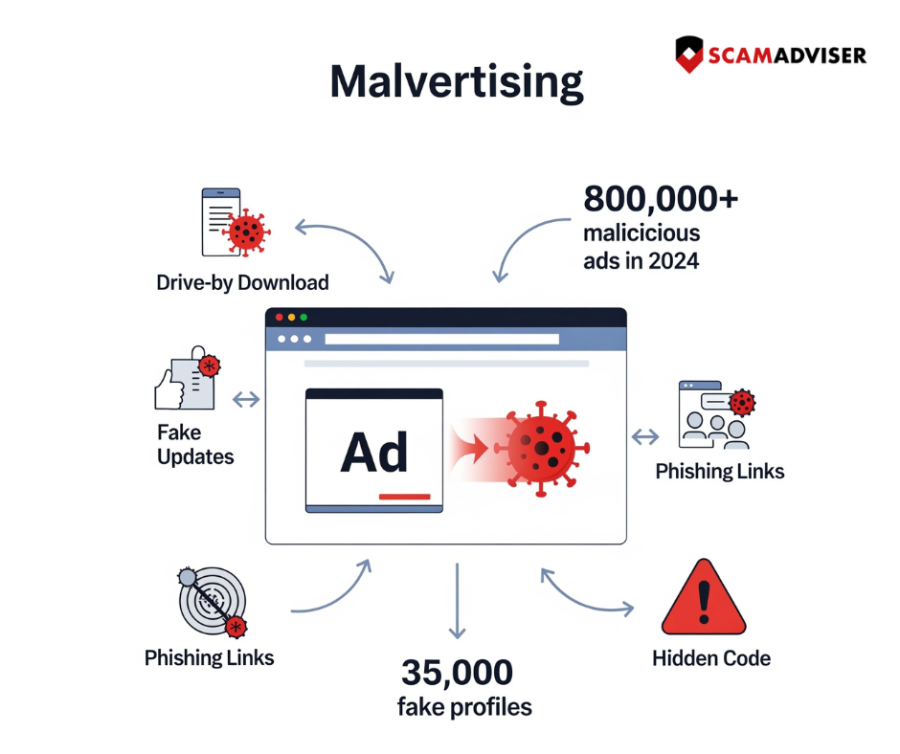Malvertising: How Innocent Ads Deliver Dangerous Malware

Author: Adam Collins
Not every ad you see online has your best interests in mind. In fact, some ads are specifically designed to exploit your trust. Enter malvertising — a sneaky form of cyberattack that uses legitimate online advertising to spread malware. You don’t even need to click anything; sometimes, just loading a web page is enough to get infected.
This silent threat is growing. In 2024 alone, nearly 800,000 malicious ads were detected, linked to over 35,000 fake social media profiles. From cryptojacking to credential theft, malvertising campaigns have evolved far beyond annoying pop-ups. If you spend time online, especially if you manage a small business or hold digital assets, this guide is for you. We'll break down how malvertising works, reveal key fraud & scams trends, and give you practical tips to stay safe.
What is Malvertising?
Malvertising (short for "malicious advertising") is a cyberattack that injects malware into seemingly legitimate online ads. These ads are placed on real websites through ad networks, making them hard to spot. The danger? They often appear on platforms you trust — news sites, search engines, streaming services — and look no different from regular ads.
Malvertising vs. Adware
While malvertising and adware both involve unwanted digital advertising, they operate very differently:
- Malvertising is designed to harm. It's used to secretly install malware on your device or redirect you to phishing sites.
- Adware, while annoying, typically comes bundled with free software and shows you unwanted ads. It can be intrusive and gather personal data, but it's not always malicious in the same way malvertising is.
How Malvertising Works: The Attack Chain
Malvertising preys on the complexity of digital advertising. Here’s how a typical attack unfolds:
- Malicious Ad Creation: Attackers create what looks like a normal ad but is laced with hidden malware.
- Infiltrating Ad Networks: These ads are submitted to advertising platforms, often using fake business credentials or stolen identities.
- Delivery to Reputable Websites: Once accepted, the malicious ads can appear on countless websites, sometimes even on the homepage of trusted news outlets.
- Execution of the Attack: When you visit a page with one of these ads, you might be infected through:
- Drive-by Downloads: Malware installs automatically without clicking anything.
- Malicious Redirects: Clicking the ad takes you to a fake website that steals information or installs malware.
- Fake Updates: Ads prompt fake alerts that trick you into downloading malware.
- Scareware: Ads claim your device is infected and pressure you into downloading a bogus "fix."
- Hidden Code: Malicious scripts can be hidden in tiny tracking pixels or invisible frames (iframes).
Why Malvertising Matters
Malvertising can have serious consequences for both individuals and organizations.
For Individuals:
- Identity theft
- Financial fraud
- Compromised devices
- Loss of personal data
- Ransomware attacks
For Businesses:
- Data breaches
- System-wide malware infections
- Reputational harm
- Regulatory fines for non-compliance
A single malicious ad can reach millions of users across multiple websites in seconds, making it a powerful tool for cybercriminals.
Real-Life Malvertising Examples & The Latest Trends

Malvertising continues to evolve. Here are some of the most significant examples and trends:
Historical Campaigns:
- Angler Exploit Kit: Used drive-by downloads to infect users with ransomware and banking Trojans.
- RoughTed (2017): Evaded ad blockers and antivirus programs, redirecting users to fake tech support pages.
- Yahoo! Malvertising (2014): Malicious ads reached millions via Yahoo!
- Spotify (2011): Ads on the Spotify platform infected users with malware.
Emerging Trends:
- Fake Google Ads: Attackers mimic real businesses in sponsored search results to steal credentials.
- Fake CAPTCHA Pages: Malware disguised as security checks, running malicious code in the background.
- AI-Powered Malvertising: AI is used to craft convincing ads and optimize delivery for higher infection rates.
- Steganography: Malware hidden within images or videos.
- Mobile Malware & Cryptojacking: Fake QR codes or crypto trading apps target phones, using your device to mine crypto without consent.
- Fake Invoices & Renewals: Ads that look like payment requests or subscription notices to trick employees.
These threats aren’t limited to outdated sites or shady downloads. They're on the platforms you use every day.
How to Protect Yourself Against Malvertising
Malvertising isn’t going anywhere, but there are steps you can take to protect yourself:
- Use an Ad Blocker: Tools like uBlock Origin can block most ads before they load.
- Keep Software Updated: Patches close the vulnerabilities that malvertising often exploits.
- Install Reputable Security Software: Choose antivirus or anti-malware solutions with real-time protection.
- Enable Click-to-Play: Prevent automatic execution of plugins like Flash or Java.
- Think Before You Click: ~ ~ Hover to preview URLs
~ Watch for low-quality images or grammar errors
~ Avoid too-good-to-be-true offers or urgent pop-ups - Download Apps Safely: Only install apps from official app stores or trusted sources.
- Clear Your Browser Cache: This helps remove any harmful temporary files.
- Educate Yourself: Awareness is half the battle. Stay updated on common scams and evolving threats.
- Report Suspicious Ads: Notify the website or ad network to help stop the spread.
Bottom Line: One Bad Click Can Cost More Than You Think
Malvertising is a growing and sophisticated threat that hides in plain sight. As online ads become more targeted and data-driven, so do the methods cybercriminals use to exploit them. You don’t need to stop using the internet, but you do need to be smarter about how you navigate it.
With a mix of good tools, updated software, and awareness of the risks, you can keep yourself and your business safe. Because in the digital world, even one bad click can cost more than you think.
Report a Scam!

Have you fallen for a hoax, bought a fake product? Report the site and warn others!
Scam Categories
Help & Info
Popular Stories
As the influence of the internet rises, so does the prevalence of online scams. There are fraudsters making all kinds of claims to trap victims online - from fake investment opportunities to online stores - and the internet allows them to operate from any part of the world with anonymity. The ability to spot online scams is an important skill to have as the virtual world is increasingly becoming a part of every facet of our lives. The below tips will help you identify the signs which can indicate that a website could be a scam. Common Sense: Too Good To Be True When looking for goods online, a great deal can be very enticing. A Gucci bag or a new iPhone for half the price? Who wouldn’t want to grab such a deal? Scammers know this too and try to take advantage of the fact. If an online deal looks too good to be true, think twice and double-check things. The easiest way to do this is to simply check out the same product at competing websites (that you trust). If the difference in prices is huge, it might be better to double-check the rest of the website. Check Out the Social Media Links Social media is a core part of ecommerce businesses these days and consumers often expect online shops to have a social media presence. Scammers know this and often insert logos of social media sites on their websites. Scratching beneath the surface often reveals this fu
So the worst has come to pass - you realise you parted with your money too fast, and the site you used was a scam - what now? Well first of all, don’t despair!! If you think you have been scammed, the first port of call when having an issue is to simply ask for a refund. This is the first and easiest step to determine whether you are dealing with a genuine company or scammers. Sadly, getting your money back from a scammer is not as simple as just asking. If you are indeed dealing with scammers, the procedure (and chance) of getting your money back varies depending on the payment method you used. PayPal Debit card/Credit card Bank transfer Wire transfer Google Pay Bitcoin PayPal If you used PayPal, you have a strong chance of getting your money back if you were scammed. On their website, you can file a dispute within 180 calendar days of your purchase. Conditions to file a dispute: The simplest situation is that you ordered from an online store and it has not arrived. In this case this is what PayPal states: "If your order never shows up and the seller can't provide proof of shipment or delivery, you'll get a full refund. It's that simple." The scammer has sent you a completely different item. For example, you ordered a PlayStation 4, but instead received only a Playstation controller. The condition of the item was misrepresented on the product page. This could be the
